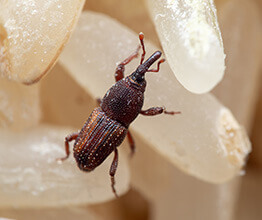WHAT DO rice weevils LOOK LIKE

Adult rice weevils, Sitophilus oryzae (Coleoptera: Curculionidae), are close relatives to grain weevils and maize weevils and are often confused with either or both. They are about 3/32 to 1/8 inch long (2-3mm) as adults with a dull reddish-brown to black color pattern. Their distinct feature is four orange/red spots on the back wing coverings (elytra). The elytra are also strongly pitted and have rows of pits within longitudinal grooves running along the coverings. The adult weevil can fly and is attracted to lights (a primary way to tell that it’s NOT grain weevil). The larval stage is legless, humpbacked, white to creamy white, with a small tan head. The maize weevil is very similar to the rice weevil, but larger.
The adult female rice weevil lays an average of 4 eggs per day and may live for four to five months (producing 250-400 eggs). A single generation can be completed in around 28 days. The eggs hatch in about 3 days. The larvae feed inside the grain kernel for an average of 18 days. The pupal stage lasts an average of 6 days (5-16 range). The new adult will remain in the seed for 3 to 4 days while its cuticle hardens and matures.
The adult female rice weevil lays an average of 4 eggs per day and may live for four to five months (producing 250-400 eggs). A single generation can be completed in around 28 days. The eggs hatch in about 3 days. The larvae feed inside the grain kernel for an average of 18 days. The pupal stage lasts an average of 6 days (5-16 range). The new adult will remain in the seed for 3 to 4 days while its cuticle hardens and matures.